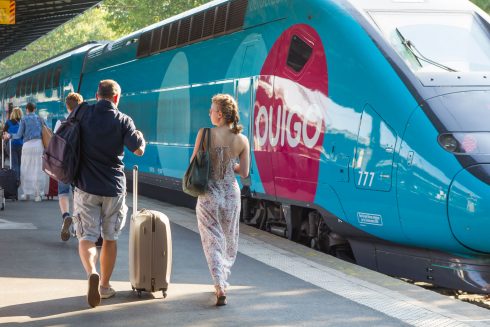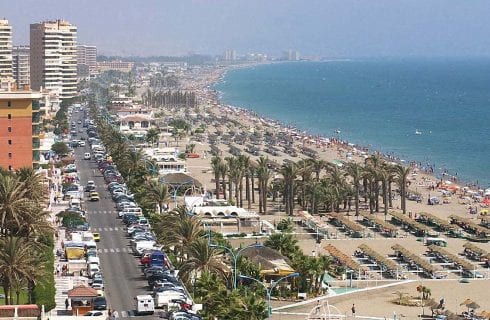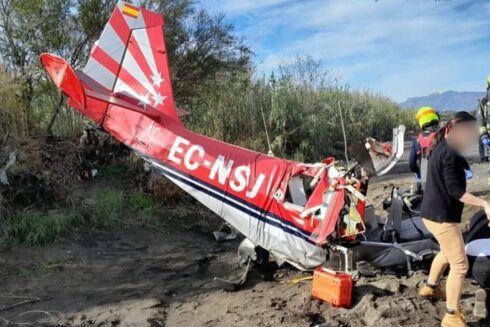EL Torcal Park Nature Reserve is known as the enchanted mountain range. It is not somewhere for the faint hearted or for those scared of heights. On my first visit to this most astonishing of Spanish landmarks in January 2005, it must also have been the coldest place in Spain.
The inhabitants of the nearby town of Antequera , and surrounding villages, had awoken to a blanket of snow. Unexpected and unusual for a place that is less than 40 kilometres north of Málaga. Indeed, that weekend children were building snowmen only 10 kilometres from the beach at Málaga. It was the first time many of them had seen snow.
Meanwhile back in the mountain range, the locals braved icy roads to see the winter wonderland that was El Torcal. The bushes, grass, plants and vegetation were covered in ice. It was as though it had been sprayed for a film set.
People got out of their cars, felt how cold it was, had the briefest of glimpses of the mountains and then ran back to their vehicles and put their heaters on full blast. Only the bravest stayed long enough to fully admire the views of the countryside and the Málaga coastline in the distance.
Tourists trying to take photos of this always impressive location, on this particularly spectacular day, had to be quick. The wind chill factor was such that even gloves could not prevent snappers from losing the feeling in their fingers. It was that cold!
Thankfully, it is not always like that. It was an exceptional day in the live of a limestone rock formation that raised its head from under the sea one hundred million years ago. Then, seismic movements of the Earth’s crust forced it up and up and up.
El Torcal now stands at 1,300 metres above sea level. Despite this vast change in its position, the limestone has still kept its layered horizontal formation. Over many centuries, wind and rain penetrated the rocks and chiselled out the eye catching shapes that can be witnessed today. The finest sculptor could not have created such an impressive piece of work.
Millions of years ago the sea of Tetis flooded this area of Andalucía. It led to the erosion that constantly created, destroyed and then created again the shape of the mountain range. For much of the year the rock is bare. Then in spring the plant life makes a colourful appearance. Red peonies, orchids and lilies sit side by side with wild rose trees. Their colour set against the starkness of the ancient rock is impressive.
To reach the 17 kilometres of El Torcal it is possible to drive up to 1,100 m above sea level along a good access road into the park.
For walkers the place is paradise. Three clearly defined routes through the park have been marked out with different coloured arrows. The green route is the shortest and easiest, taking aroun half an hour.
The yellow route is two and a half kilometres in length and takes you to the area known as Las Ventanillas. Here, at 1,200 metres, you have a “window” view on the world below.
Finally, and for serious walkers only, there is the red route. Be warned this almost five-kilometre trek is hard going and will take around three hours to complete. From the viewing point at 1,339 metres you can see the whole of the El Torcal Park and, on a clear day, the coastline of Africa.
Stand here and it is hard to accept that the pretty and sedate town of Antequera is just ten kilometres away.
Euan Woodward, a Training and Development Consultant, moved to nearby Mollina after living further north in Spain.
He says: “My priorities were having an airport nearby so that I could return to the UK for work without driving long distances. I also wanted to be based in a traditional Spanish town. Being a regular churchgoer, it was also important to find a village had a friendly and active church.
“I saw Mollina and liked it very much. Then I went just down the road to Antequera and thought that was the icing on the cake. I sat outside cafes and watched the world go by and was really taken by the feel of the place.
“Antequera has lovely restaurants, plenty of shops; the mountain range El Torcal, which you can drive up to, is 10 minutes away as is the marvellous Lobo Wolf Park. I really like both those places. The best thing about Antequera is that I feel at peace there. The place just feels right for me.”
From whichever direction you approach the foothills of the Sierra Pelada you have magical views. Keep looking down though as El Torcal is also home to the Montpelier snake – all two metres in length of it. Look up and you might be lucky enough to witness a Griffon vulture in flight.
I made my second visit to El Torcal on a hot July day this year. It provided relief from the boiling temperatures in Antequera. At night the summer moon acts like a floodlight, lighting up the nearby villages of the Valle del Guadalhorce and the Mediterranean coastline.
A word of warning is required at this juncture. People have been known to get lost on El Torcal in daylight, so do not consider wandering through the park during the night.
Villanueva de la Concepción is known locally as “al pie de Torcal” or, at the foot of Torcal. It is a place that is accustomed to welcoming visitors.
Agent Sarah Rick of www.torcalestates.com confirms that more and more people are seeking isolation.
She says: “British buyers are increasingly interested in country properties because of the land, views and
solitude. Some specifically ask for views of El Torcal.”
Sarah is currently offering a three bedroom house for sale at a price of 350,000 euros (ref 568). It is surrounded by seven thousand square metres of land and has undisturbed views of the mountain range.
The population of Villanueva de la Concepción is increasing at a fast rate. There is a large amount of new housing being developed, many of which are aimed not just at younger Spanish buyers but also at the international market.
There is seemingly an exodus from the Marbella and Fuengirola coastline. Many nationalities are looking to buy inland. Ronda is the most sought after location but agents report increasing interest in the villages close to El Torcal.
In Villanueva de la Concepción Trevor Pearson is selling a three year old, two bedroom apartment that has superb views of El Torcal. It is being sold, fully furnished, for 139,000 euros (sunshinevillas@terra.es).
Trevor lives in a villa nearby and confirms that people are increasingly keen to buy inland.
He says: “This is still a relatively undiscovered area. Villanueva de la Concepción is one of the up and coming
villages in the whole of Spain . It has a new sports centre and public swimming pool. Prices here are rocketing
but none of the new properties have the view on offer from the balcony of my apartment. I am biased, I know, but it has the best view of El Torcal on offer.”
So today’s hunter-gatherers are homebuyers.
In that respect little has altered here for centuries. Recent archaeological excavations brought to the surface a collection of prehistoric stones which suggest that hunter-gatherers lived in Villaneuava as long ago as 60,000BC.
There has been a human settlement on the site of Villanueva de la Concepción since 200BC, when Roman invaders established a small town they called Oscua. Ruins of Roman villas, a burial ground and a theatre can still be seen today.
The Moors captured Villanueva shortly after their invasion 711AD. They built the nearby castle, el Castillo de Xébar. The Christians took the castle in 1410. They reinforced it but after the reconquest the castle lost its military importance and was abandoned.
Villanueva was a small hamlet and only declared a village by decree from the Málaga government in 1880. As an incentive to new settlers, the sons of those moving there were exempt from military service and no taxes were levied on any agriculture.
Today, agriculture is still the lifeblood of places like Villanueva and nearby Casabermeja. Rural tourism is making its presence felt. New hotels, shops, bars and restaurants are appearing on a regular basis.
Modern day incentives to encourage new homebuyers might consist of developers paying certain legal charges or cash back on completion offers. There is clearly a demand for new build in the area.
It is true that being so close to the coast is beneficial and that having the ever growing Málaga airport on your doorstep saves much time. It is equally the case that Antequera is a pleasant place in which to shop or to wander.
However, there is one chief reason to live in one of the pretty towns or villages in this region. At any time of day or night; at any time of the year, you can stand on top of the world.
It is called El Torcal.








